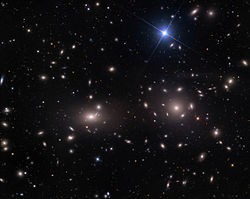Caldwell 35
Caldwell 35, another of astronomer William Herschel’s discoveries, is a giant elliptical galaxy, the largest and brightest galaxy near the center of this Hubble image. It is accompanied by other members of the Coma cluster of galaxies, and is set against a backdrop of hundreds of even more distant galaxies. (One bright star on the right side of the image, and a dimmer star above it, belong to our own galaxy.)
Scientists believe Caldwell 35 is about two and a half times larger than the Milky Way. Hidden in the heart of this tranquil-seeming galaxy lies a supermassive black hole. With a mass 21 billion times greater than the Sun, it is the most colossal black hole ever discovered. (For comparison, the black hole at the center of our galaxy is thought to be 4 million times more massive than the Sun.)
Black holes usually spark visions of stars and planets hurtling into the inky blackness of a tornado-like vortex, clutched in the unrelenting grip of unseen forces. While Caldwell 35’s black hole used to feed on material in its younger years, astronomers believe its galactic buffet has run out and it has stopped feeding. Not only are stars not being sucked in, brand new stars are actually forming and orbiting peacefully about the black hole.
This image was taken with Hubble's Advanced Camera for Surveys in visible and infrared light. With a magnitude of 11.5, Caldwell 35 is best seen using a large telescope under dark skies. As in the Hubble image, a number of fainter galaxies can be seen accompanying Caldwell 35 in the field of view. From the Northern Hemisphere, late spring is the ideal time to view the galaxy, which is located in the constellation Coma Berenices. From the Southern Hemisphere, look for it in the late autumn.
For more information about Hubble’s observations of Caldwell 35, see:
www.spacetelescope.org/images/heic1602a/
Credit: NASA & ESA
For Hubble's Caldwell catalog site and information on how to find these objects in the night sky, visit:
www.nasa.gov/content/goddard/hubble-s-caldwell-catalogRelevantní obrázky
Relevantní články
NGC 4889NGC 4889 je obří eliptická galaxie v souhvězdí Vlasů Bereniky vzdálená přibližně 304 milionů světelných let. Objevil ji britský astronom William Herschel v roce 1785 a zapsal ji do svého katalogu jako jasnou mlhovinnou skvrnu. NGC 4889 je spolu s NGC 4874 (Coma A) nejjasnějším členem Kupy galaxií ve Vlasech Bereniky. Na rozdíl od plochých spirálních galaxií, jako je galaxie Mléčná dráha, nemá NGC 4889 viditelné prachové pásy ani spirální ramena a má hladký jednotvárný vejčitý vzhled, jehož jasnost klesá od jádra směrem k okraji. V centru této galaxie se nachází obří černá díra, která zahřívá mezihvězdné prostředí třením přitahovaného prachu a plynů. Rentgenové záření z galaxie se šíří na vzdálenost několika milionů světelných let. .. pokračovat ve čtení





